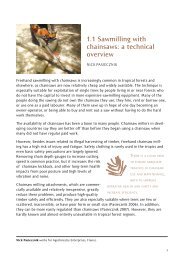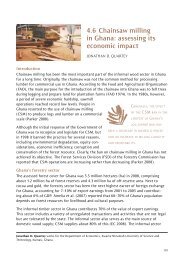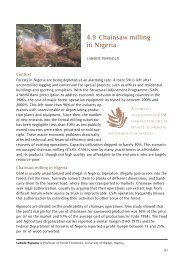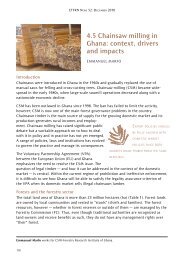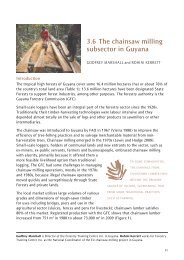Chainsaw milling: supplier to local markets - European Tropical ...
Chainsaw milling: supplier to local markets - European Tropical ...
Chainsaw milling: supplier to local markets - European Tropical ...
Create successful ePaper yourself
Turn your PDF publications into a flip-book with our unique Google optimized e-Paper software.
ETFRN NEws 52: DEcEmbER 2010<br />
This article is aimed at those involved in making and implementing policies in the forestry<br />
and wood processing sec<strong>to</strong>rs, and companies involved in manufacturing and selling chainsaws,<br />
accessories and <strong>milling</strong> equipment. There is a need <strong>to</strong> ensure and promote adequate<br />
training in chainsaw use, make available appropriate safety and <strong>milling</strong> equipment, and<br />
develop <strong>markets</strong> for value-added end products.<br />
a brief his<strong>to</strong>ry of chainsaw <strong>milling</strong><br />
The first records of the use of <strong>to</strong>othed saws are from Egypt at least 5000 years ago. long<br />
one- and two-handled saws became common <strong>to</strong>ols for felling, cross-cutting and <strong>milling</strong>,<br />
and designs have changed little over time. The continued use of handsaws for saw<strong>milling</strong><br />
should not be underestimated, although they are being rapidly replaced by freehand<br />
chainsaws. The blade is used vertically, with logs that are either raised on<strong>to</strong> specially<br />
constructed frames, or more commonly as pitsaws, where a pit is dug under one end of<br />
a felled tree. The person on <strong>to</strong>p of the log was once known as the <strong>to</strong>p dog, and the one<br />
underneath, continuously covered in sweat and sawdust, the underdog, which is thought<br />
<strong>to</strong> be the origin of this word in English.<br />
a revolution in saw<strong>milling</strong> technology came with the invention of the circular saw blade<br />
in 1777, though more primitive versions were available before. it was not fully adapted<br />
for saw<strong>milling</strong> timber until the early 1800s, coinciding with the invention of the first band<br />
saw. both types of saw could be powered by water, though their evolution in the 1800s<br />
paralleled the rapid development of steam power applications.<br />
however, no mill before 1900 could be described as portable. The advent of petrol-driven<br />
engines and the increasing demand for timber finally provided the incentive <strong>to</strong> develop<br />
appropriate machines for use within forests. portable circular saws developed in the early<br />
1900s, although these were made redundant by the arrival of the modern petrol chainsaw<br />
in 1929. The use of a continuously linked chain for cutting had been invented a century<br />
earlier in 1830 for cutting bones during surgery; it <strong>to</strong>ok 50 years <strong>to</strong> be adapted <strong>to</strong> cutting<br />
timber, and another 50 years of various unwieldy pro<strong>to</strong>types before andreas stihl came up<br />
with the chainsaw design that we recognize <strong>to</strong>day.<br />
<strong>Chainsaw</strong>s were principally designed for felling and cross-cutting, and not for ripsawing<br />
(cutting logs in<strong>to</strong> timber along the grain or length of a log). however, chainsaws were<br />
used in other types of less portable <strong>milling</strong> systems by the 1950s, if not earlier. The first<br />
<strong>milling</strong> attachments were frame mills; the Granberg alaskan mill (Granberg, usa) was<br />
commercialized in 1962, followed by the Gruminette (Zimmer, France) and others. These<br />
models have changed little in half a century. around the same time, the first ripping chain<br />
specially designed for chainsaw <strong>milling</strong> was invented and patented. it is now manufactured<br />
by several companies, notably Granberg, oregon and stihl. rail mills followed, such<br />
as the mini mill in 1973 (Granberg, usa) and the beam machine in 1982 (Quadra Tools,<br />
Canada). Carriage mills are the most recent development. They include the m7 (logosol,<br />
sweden) and the J100 (Jober, Canada), which use chainsaws or bandsaw cutting heads, and<br />
a bandsaw head powered by a single chainsaw engine (the ripsaw, sir, usa).<br />
4



